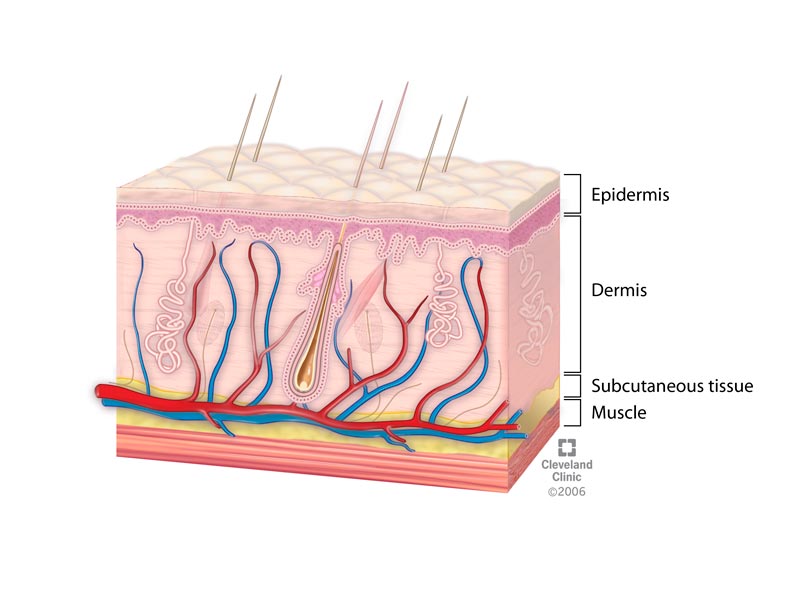Finally Merkel cells make up less than 1 of all. They divide to form the keratinocytes of the stratum spinosum.

Pin By Jennifer Seim On School Epidermis Dermis Vascular
Melanin is a pigment that serves to protect DNA from UV radiation.

. The function of the relatively thick dermis is to protect the organism against injury and attacks. Skin contains many specialized cells and structures. Epidermis the outer most layer of the skin varies in thickness in different regions of the body.
The melanin is transferred into the keratinocytes via a cellular vesicle called a melanosome Figure 517. The retina actually consists of two components. Langerhans cells are the third most common cells in the epidermis and make up just over 1 of all epidermal cells.
Melanin ˈ m ɛ l ə n ɪ n. Melanin is a dark pigment primarily responsible for skin colorOnce synthesized melanin is contained in special organelles called. Epithelium and the epidermis of the skin or of conditionally dividing cells eg hepatic and renal parenchymal cells because the apoptotic cells are readily replaced.
Melanocytes produce the pigment melanin to protect the skin from ultraviolet radiation and sunburn. However the synthesis. Melanin is a black pigment synthesized nonenzymatically or enzymatically from dopamine l-DOPA and l-tyrosine.
The value of apoptosis as. An outermost layer of retinal pigment epithelium RPE which is composed of single layer of cuboidal melanin-containing cells and the neural retina which is a multilayered structure containing photoreceptors as well as neurons and glia. Skin cancer is the result of uncontrolled growth of abnormal skin cells that takes place when skin cells suffer DNA damage and then mutate causing them to multiply rapidly and form malignant cancerous tumors.
Compare with passive immunity Acute. It is divided into three main layers viz. Apoptosis of damaged cells has a full value as a tissue repair process only for tissues that are made up of constantly renewing cells eg the bone marrow the respiratory and GI.
13 Blood supply to the skin also reduced as we age impairs wound healing and interferes with what we recognize as signs of inflammation such as. Langerhans cells role is to detect and fight pathogens that attempt to enter the body through the skin. Immunity produced when an animals own immune system reacts to a stimulus eg a virus or bacteria and produces antibodies and cells which will protectit from the disease caused by the bacteria or virus.
Different skin tones are due to differences in the amount of melanin size and density once transferred from melanocytes to keratinocytes via melanosomes rather than the number of melanocytes. Melanin-containing cells including catecholaminergic CA cells in the brain and melanocytes of the hair and skin pigment cells in the inner ear iris and choroid of the eye originate from the neural crest. The color of skin is influenced by a number of pigments including melanin carotene and hemoglobin.
The stratum basale is primarily made up of basal keratinocyte cells which can be considered the stem cells of the epidermis. DEVELOPMENT AND FUNCTION OF THE CORIUM SKIN. The stratum basale also called the stratum germinativum is the deepest epidermal layer and attaches the epidermis to the basal lamina below which lie the layers of the dermisThe cells in the stratum basale bond to the dermis via intertwining collagen fibers referred to as the basement membrane.
Melanocytes are melanin-producing neural crest-derived cells located in the bottom layer the stratum basale of the skins epidermis the middle layer of the eye the uvea the inner ear vaginal epithelium meninges bones and heart. The corium skin is composed largely of melanocytes which are the cells that make the pigment melanin that. Each layer provides a distinct role in the overall function of the skin.
In life these two components are fused into what we typically call the retina and it is subdivided. Black dark is a broad term for a group of natural pigments found in most organismsMelanin is produced through a multistage chemical process known as melanogenesis where the oxidation of the amino acid tyrosine is followed by polymerizationThe melanin pigments are produced in a specialized. A finger-like projection or fold known as the dermal papilla.
Having a sudden and generally severe onset. These cells are responsible for the production of melanin from tyrosine. Epidermis dermis and hypodermis.
The epidermis is made up of 95 keratinocytes but also contains melanocytes Langerhans cells Merkel cells and inflammatory cells. Recall that melanin is produced by cells called melanocytes which are found scattered throughout the stratum basale of the epidermis. The skin consists of two main layers namely the epidermis outer skin and the corium skin dermis or under skin.
The sluggish replacement of epidermal cells and a decline in the production of melanin decrease the skins ability to protect against exposure to the suns ultraviolet rays and increase the risk of sunburn and skin cancer in elders. It is the thinnest on the eyelids 005 mm and the thickest on the palms and soles 15. Layers of the epidermis.
Most skin cancers develop on the visible outer layer of the skin the epidermis particularly on sun-exposed areas such as the face head hands arms and legs.

Does Our Skin Protect Us From Uv Light How The Bio Teacher

Skin Layers Structure And Function

1 P R O T E C T I O N Functions Of The Skin A Brazilian Reasons 0019 1 Protection Skinprotection Skin Protection Skin Cancer Hair Removal Permanent

Melanocytes Localization In The Epidermis And Hair The Epidermal Download Scientific Diagram
0 Comments